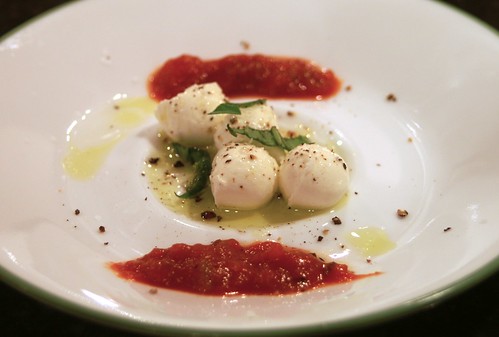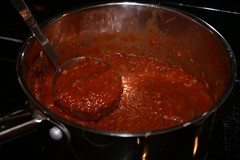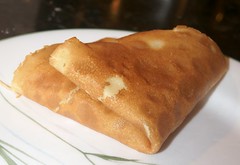
A while back we made an attempt at doing homemade pizza, following the
Alton Brown recipe (show transcript
here). Although the results were edible, they weren't very pretty, and we had a lot of trouble getting the pizzas in and out of the oven.
The main problem was that we didn't have a
pizza peel. In retrospect, trying to do pizza without one was a mistake, and I wish we had bought one earlier than we did. It's hard to overstate the difference having a peel makes, in terms of not dumping your pizza all over the inside of your oven.
In addition to a pizza peel, the other piece of special equipment you need is either a (fancy, expensive)
pizza stone or a bunch of (cheap) unglazed quarry tiles. These go on the very bottom rack of your oven when it's in the lowest position, right over the heating coil. We found 8" square unglazed tiles for less than 50¢ each at Home Depot — six fills one of our oven racks well, while still leaving room for air to circulate.
Although having two basically single-purpose gadgets makes this a fairly equipment-intensive recipe, we thought the results were more than worth it. The procedure borrows both from
Alton Brown's “Pizza Pizzas” and
101 Cookbooks' “Best Pizza Dough Ever” recipes. I modified the recipe slightly in order to make it somewhat faster, and to use Active Dry rather than instant yeast.
Dough Ingredients:
- 1-1/2 c. warm water (~100F)
- 2 packets Active Dry yeast
- 4 tbsp. white sugar
- 4 c. bread flour
- 1-1/2 tbsp. kosher salt (if using regular table salt, use half)
- 2 tbsp. olive oil
Pizza Ingredients:
- 1 c. pizza sauce (see our recipe for Green Pepper Pizza Sauce)
- 1/2 lb. (8 oz.) fresh mozzarella (the small, 3/4" dia. balls are convenient, sliced in half)
- Shredded or grated Parmesan or Romano cheese, to taste
- Fresh basil, to taste
Preparing the Dough:
- Bloom the yeast by mixing 2 tbsp. of sugar into the warm water, and then pouring the yeast on top. Set aside momentarily.
- Place bread flour, salt, and the other 2 tbsp. sugar into the work bowl of a stand mixer with the paddle blade attached. Combine on low.
- Add the olive oil to the liquid, and then slowly pour it into the mixer, forming a sticky dough.
- As soon as the dough comes together, stop mixer and swap paddle blade for greased (with pan-release spray) dough hook.
- Knead dough using hook for about 15 minutes. Start the mixer slowly (2 or 3 on a KitchenAid) and then work up to a faster speed (4 or 5) as the dough gets smoother and more glutenous. The dough should ‘slap’ against the side of the bowl with each rotation. (Placing a non-skid mat under the mixer prevents it from ‘walking.’)
- If after 10 minutes or so of kneading dough still sticks to sides of work bowl, add additional flour by 1/2 tablespoons until it clears. It's okay for dough to still stick to the bottom of the bowl, but it should pull cleanly away from the sides. (We had to add about a tablespoon.)
- Test the dough by pulling out a small piece and checking for the ‘windowpane.’ This is where the dough can be stretched thin enough to be translucent, without tearing first. If dough tears, continue kneading and testing in 5-minute increments. Dough should be sticky but not unworkably so; if it's too sticky to stretch, add more flour by 1/2-tablespoonsfuls while kneading.
- Turn the dough out into a bowl lightly coated with olive oil. (Alternately, if you're careful, you can do this in the mixer's work bowl by ‘catching’ the dough on the hook, raising it up so it's clear of the bowl, dumping some olive oil in, spreading it around, and then plopping the dough back into the bowl.) Cover with plastic wrap.
- Allow dough to rise in room-temperature location for about 4-5 hours. (At this point, the internal temperature of our dough was 86F and the room was 74F.)
- When dough has doubled in size, punch down, removing as many bubbles as possible. Allow to rise for a further 2 hours or so.
- Turn dough out onto countertop and divide into quarters. Shape each piece into a tight ball. Dough not intended for immediate use should be placed into greased zip-top bags and frozen.
Making the pizzas:
- Place pizza stone or quarry tiles on very bottom rack of oven (if using a gas oven without a heating coil, place directly on the bottom surface of the oven). Preheat oven to 500F.
- Gently stretch dough pieces into 8" rounds, then allow to rest on floured countertop for about 10-15 minutes. This gives the dough time to relax and prevents tearing.
- Stretch dough out to 12" round, dust one side with corn meal, and place (cornmeal side down) on pizza peel. Dough should side around easily on the peel; if not, add more cornmeal to the bottom.
- Spread 1/2 c. sauce across the top, then add 4 oz. (half of the 8 oz. container) mozzarella, and as much Parmesan or Romano cheese as desired — but don't overdo it; the pizza will get greasy if you add more than a sprinkle for flavor.
- Once the oven is up to temperature, use the peel to place the pizza onto the hot stone/tiles. The only trick here is to never try to ‘push’ the pizza; you'll just make a mess. Instead, let the far end of the pizza slide off until it contacts the stone, and then gently pull the peel out from under it, allowing it to drop.
- Cook until crust is brown. It helps if your oven's internal light works, so you can watch the pizza without opening the oven door. In our oven this was about 8 minutes, but be watchful.
- Remove pizza using the peel. Depending on the thickness of your peel, you may be able to just slide it under the pizza and remove it, but you may need a little help from a fork to keep from pushing it off the back of the rack.
- Place pizza onto wire cooling racks, and allow to cool for at least 5 minutes before slicing. If properly cooked, the bottom should be dark brown but not black.
- Garnish with chopped fresh basil, if desired.
- Serve with beer.
Final Thoughts:
Compared to the original Alton Brown recipe, this version doesn't have quite the perfect chewiness and texture. However, it is significantly faster and can be started the same day you want to eat, rather than the night before. If you have time to let the dough rise for 24 hours, by all means use either of the slower, cold-rising recipes, but if you only have 8 hours, we think this one gets about 80% of the flavor in a third of the time.






